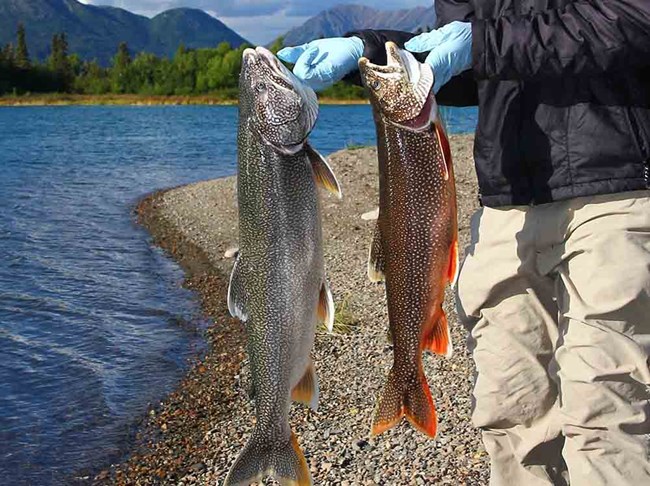Last updated: April 1, 2022
Article
How does mercury reach pristine lakes?

Mercury is a widespread element and persistent pollutant that enters aquatic food webs through various sources and pathways. Airborne emissions can travel long distances across the globe, depositing mercury far from human sources. Other sources occur naturally within the landscape. But how is it that remote, otherwise pristine lakes in Alaska parks contain fish with elevated levels of mercury? We study lake trout to find out.
Lake trout are a long-lived, slow-growing, top predator fish common in many southwest Alaska lakes. Because mercury bioaccumulates in long-lived species and biomagnifies up the food chain, lake trout are a good indicator of the amount of mercury present. Previously, we found that lake trout in southwest Alaska have variable and, in some cases, very elevated mercury concentrations. In this study, we analyzed lake trout tissue from two parks for stable isotopes of mercury to assess the importance of mercury from different inputs, including: from the atmosphere (via wet deposition), ocean (via salmon migration), and land (via volcanic activity). Our results suggest that:
-
Atmospheric deposition delivers uniform levels of mercury across the study area, so deposition cannot explain the variation in lake trout mercury concentrations among lakes.
-
Migrating salmon deliver little mercury to lake trout directly, although salmon might provide an indirect source.
-
Active volcanoes deliver additional mercury to nearby lakes, forming a novel route of mercury exposure to aquatic food webs.
These results could help answer lingering questions about which mercury sources are bioavailable and how important volcanic emissions are to regional mercury budgets. This study is relevant and timely, as recent efforts to ban mercury use globally highlight the need for biological monitoring programs to understand the relative importance of mercury inputs.
Using Carbon, Nitrogen, and Mercury Isotope Values to Distinguish Mercury Sources to Alaskan Lake Trout
Abstract
Lake trout (Salvelinus namaycush), collected from 13 remote lakes located in southwestern Alaska, were analyzed for carbon, nitrogen, and mercury (Hg) stable isotope values to assess the importance of migrating oceanic salmon, volcanic activity, and atmospheric deposition to fish Hg burden. Methylmercury (MeHg) bioaccumulation in phytoplankton (5.0–6.9 kg L–1) was also measured to quantify the basal uptake of MeHg to these aquatic food webs. Hg isotope values in lake trout revealed that while the extent of precipitation-delivered Hg was similar across the entire study area, volcanic Hg is likely an important additional source to lake trout in proximate lakes. In contrast, migratory salmon (Oncorhynchus nerka) deliver little MeHg to lake trout directly, although indirect delivery processes via decay could exist. A high level of variability in carbon, nitrogen, and Hg isotope values indicates niche partitioning in lake trout populations within each lake and that a complex suite of ecological interactions is occurring, complicating the conceptually linear assessment of the contaminant source to the receiving organism. Without connecting energy and contaminant isotope axes, we would not have understood why lake trout from these pristine lakes have highly variable Hg burdens despite consistently low water Hg and comparable age-length dynamics.
Lepak, R. F., J. M. Ogorek, K. K. Bartz, S. E. Janssen, M. T. Tate, Y. Runsheng, J. P. Hurley, D. B. Young, C. A. Eagles-Smith, and D. P. Krabbenhoft. 2022. Using carbon, nitrogen, and mercury isotope values to distinguish mercury sources to Alaskan lake trout. Environmental Science and Technology Letters.
Lepak, R. F., K. K. Bartz, J. M. Ogorek, M. T. Tate, J. F. DeWild, and S. E. Janssen. 2022. Assessment of mercury sources in Alaskan lake food webs: U.S. Geological Survey data release.
This data release includes results of raw water, soil, seston, and fish tissue samples collected from lakes in southwestern Alaska between 2011 and 2016. Specifically, these data include total mercury and methylmercury concentrations in water, size-sieved seston, and particulate matter of 13 remote lakes. Additionally, these data include soil and volcanic ash measurements from the surrounding watersheds. Finally, these data include energetic profiling of seston, lake trout, and sockeye salmon as well as mercury isotope measurements of the fishes. These data are important when interpreting mercury mass balance flows and bioavailability to the food web and are a part of an associated journal article published in Environmental Science and Technology Letters (https://doi.org/10.1021/acs.estlett.2c00096).
